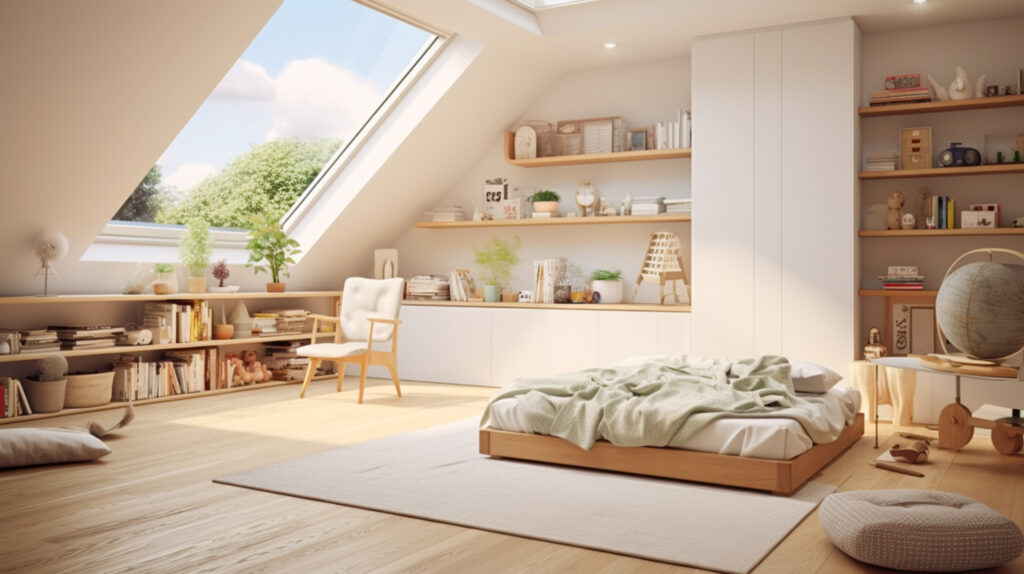The natural beauty of sunlight has a transformative effect on any living space, but perhaps nowhere is this more impactful than in a child’s room. Skylights, which allow a flood of daylight to permeate the room, can create a magical environment that stimulates the imagination, enhances mood, and contributes to health and well-being.
In this article, we will explore why you should consider adding skylights to your child’s room.
Promotes a Healthy Sleep Schedule
Children require more sleep than adults, and ensuring enough rest is crucial for their growth and development. One of the benefits of natural light in a child’s room is its ability to regulate the body’s internal clock, also known as the circadian rhythm.
Exposure to sunlight during the day helps maintain this cycle, making it easier for children to fall asleep at night and wake up refreshed in the morning. Skylights can bring in natural light, even on cloudy days, to promote a healthy sleep schedule for your child.
Enhances Mood and Productivity
Research has shown that natural light can positively affect mood and productivity levels. Sunlight triggers the release of serotonin, also known as the “feel-good” hormone, which can improve mood and reduce anxiety and stress. Studies have found that exposure to natural light can even help alleviate symptoms of depression.
By incorporating skylights into your child’s room, you provide them with a constant natural light source that can contribute to their overall well-being. This can be especially helpful during long periods spent indoors, such as during winter or if your child is recovering from an illness.
Creates a Healthy Environment
Sunlight has many health benefits, including boosting vitamin D levels and improving concentration and memory. Adding skylights to your child’s room allows them to bask in the natural light and reap these benefits.
In addition, skylights can improve air quality in the room by increasing ventilation and reducing humidity levels. This can help children with allergies or respiratory issues, promoting a healthier living space.
Sparks Creativity and Imagination
A child’s imagination knows no bounds; a bright room filled with natural light can only enhance it. Skylights can create a dreamy atmosphere and inspire children to explore new worlds through play or artistic endeavours.
Furthermore, the changing sunlight patterns throughout the day can provide endless fascination for children, encouraging them to observe and learn about the natural world.

Saves Energy and Money
Adding skylights in your child’s room brings in natural light and reduces the need for artificial lighting during the day. This can result in lower energy bills, saving you money in the long run.
Furthermore, skylights can also help regulate the temperature in the room by providing natural insulation and decreasing reliance on heating or air conditioning.
Types of Skylights
There are several types of skylights that you can consider for your child’s room, each offering its unique features and benefits:
- Fixed Skylights: These are permanently sealed skylights that do not open. They are an excellent choice for rooms that need extra light but not additional ventilation. Fixed skylights are less expensive than vented ones and have less chance of leaking, making them a cost-effective solution for a child’s room.
- Vented Skylights: Also known as roof windows, vented skylights can be opened to let in fresh air. This can benefit a child’s room as it can improve air circulation and help expel stale air, contributing to a healthier environment. They are available in manual, electric, or solar-powered versions. However, they are more expensive and may require more maintenance than fixed skylights.
- Tubular Skylights: Tubular skylights, or solar tubes, use reflective tubes to funnel light from a small, dome-shaped window in the roof to bring light into the room below. They are ideal for smaller rooms and spaces, like a child’s room, where a conventional skylight may not fit. They are low-maintenance and offer the benefits of natural light without the heat gain or loss associated with larger skylights.
- Custom Skylights: Custom skylights may be a good option if you have specific design preferences or unique architectural requirements. They can be designed and built to your specifications, allowing you to fully control the amount of light, the shape, and the placement of the skylight. This option provides the most flexibility but is also typically more expensive.
How to Choose a Skylight for Your Home
When selecting a skylight for your child’s room, consider the following factors:
- Size and Placement: Choose a size and placement that will provide adequate natural light without compromising privacy or safety. A professional can help you determine the best location for the skylight based on your home’s orientation and roof structure.
- Material Quality: Opt for high-quality materials that are durable and energy-efficient. Look for skylights with a low solar heat gain coefficient (SHGC) to prevent excessive heat from entering the room.
- Safety Features: Ensure the skylight has proper safety features, such as tempered or laminated glass and secure locks, to prevent accidents.
- Professional Installation: You should only work with a roofing company to ensure proper sealing and prevent leaks or damage.
Conclusion
Incorporating skylights in a child’s room can have numerous benefits, from improving sleep and mood to promoting creativity and saving energy. With various types of skylights available, you can choose the best option for your child’s room based on your specific needs.
However, it is essential to consider factors such as size, material quality, safety features, and professional installation to ensure the skylight provides maximum benefits for your child’s space. So, consider adding a skylight in your child’s room and watch them thrive in the natural light.







Leave a Reply